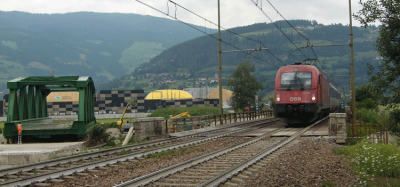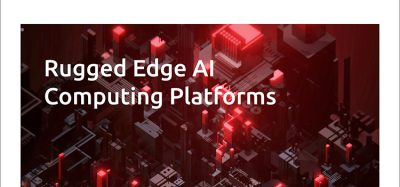Funds raised for autonomous battery-electric vehicles that move rail freight
Posted: 19 January 2022 | Parallel Systems | No comments yet
Parallel Systems has revealed it is contributing to the decarbonisation of freight by building a cleaner, automated rail future.
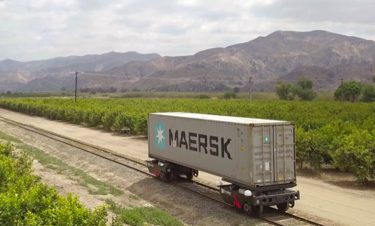

Parallel Systems’ prototype vehicle loaded with a shipping container. Credit: Parallel Systems
Parallel Systems, a company founded by former SpaceX engineers to reimagine the railroad system, has raised $49.55 million in Series A funds to build autonomous battery-electric rail vehicles that move freight.
The round is led by Anthos Capital, and includes investments from Congruent Ventures, Riot Ventures, Embark Ventures, and others. The funds will be used to build a fleet of rail vehicles, execute advanced testing programmes and grow the team. The company, which came out of stealth mode today (19 January 2022), has raised $53.15 million to date, including $3.6 million in seed funds.
Matt Soule, Co-founder and CEO of Parallel Systems, said: “We founded Parallel Systems to allow railroads to open new markets, increase infrastructure utilisation, and improve service to accelerate freight decarbonisation. Our business model is to give railroads the tools to convert some of the $700 billion U.S. trucking industry to rail. The Parallel Systems solutoin can also help alleviate the supply chain crisis by enabling low-cost and regular movement of freight in and out of ports. Parallel Systems’ competitive edge is our autonomous battery-electric rail vehicles, which are designed to move freight cleaner, faster, safer and more cost effectively than traditional trains or trucks.”
Creating a more efficient and flexible rail system
Parallel System’s patent-pending vehicle architecture combines innovative software and hardware with the historic rail industry to increase the utilisation of today’s railroads. The company’s autonomous battery-electric rail vehicles load and transport standard shipping containers as a single- or double-stacked load. The railcars, which are individually powered, can join together to form ‘platoons’ or split off to multiple destinations while en route. The railroad’s closed network is ideal for the safe and early commercialisation of autonomous technology due to limited track access and centralised traffic control.
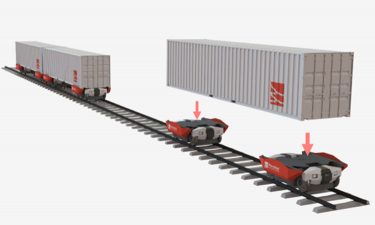

Parallel System’s ‘platoon’ architecture. Credit: Parallel Systems
The rail vehicles are more flexible than traditional trains. Unlike traditional freight trains, Parallel Systems’ platoons do not need to accumulate large quantities of freight to make service economical, which enables more responsive service and a wider range of routes. This dramatically reduces the waiting times associated with loading trains that are miles long. The system can support service at a range of distances, from across a city to across the country. Parallel Systems’ unique architecture will also bypass congested switching yards, which are historically used to manually sort and reassemble freight onto secondary trains – saving hours, or even days, of transit time. The near continuous flow of containers through terminals results in greater asset utilisation, faster delivery times, and higher quality of service.
Introducing new environmental and safety benefits to the rail industry
Parallel Systems is building a cleaner and safer rail system using automated zero-emissions technology. The company’s freight transportation solution is even more energy efficient than freight trains because it is lighter and more aerodynamic. The patent-pending platoon technology features self-propelled rail cars that push against each other to distribute the aerodynamic load. Parallel Systems’ vehicles use just 25per cent of the energy compared to a semi-truck and offer the lowest operational cost of any surface freight transportation mode. Less energy means smaller batteries, less strain on the grid, and lower charging infrastructure costs.
Parallel Systems’ zero-emission vehicles will dramatically reduce the freight industry’s carbon emissions. Trucking accounts for 444 million metric tonnes of carbon dioxide, or approximately seven per cent of all CO2 equivalent greenhouse gas (GHG) emissions in the United States, according to the 2019 U.S. Environmental Protection Agency figures. Parallel aims to significantly reduce GHG emissions by converting trucking freight to electric rail.
New levels of railway safety are possible due to the vehicle’s ability to rapidly detect hazards, such as a vehicle on the track. The railcars, which leverage a camera-based perception system and redundant braking, can stop safely and autonomously up to 10 times quicker than a train. This means the vehicles can perform an emergency stop within the line of sight that the sensors perceive an object. In addition, the platoons automatically maintain safe speeds based on the track conditions.
Parallel Systems’ platoons will reduce waiting times at railroad crossings. The platoons are shorter than traditional trains, and the vehicles will separate if blocking traffic, allowing emergency vehicles and the public to safely proceed without delays.
Invigorating the American rail industry
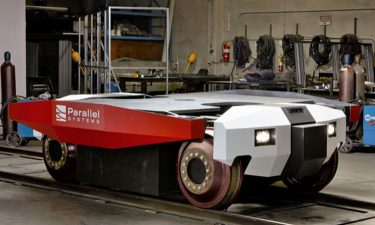

Parallel Systems’ second generation prototype vehicle. Credit: Parallel Systems
The United States has the world’s most expansive railroad system with over 140,000 miles of track; however, Parallel Systems estimates that less than three per cent of that network is occupied by active trains at any given moment. To make freight deliveries economical, today’s railroads typically focus on moving shipping containers distances more than 500 miles. ParallelSystems has identified an opportunity to bring more business to rail by improving the unit economics over shorter distances. Introducing a more flexible system will alleviate pressure on highway infrastructure and the trucking industry as it faces overwhelming demand and a driver shortage of 80,000 U.S. drivers.
Parallel Systems’ unique system eliminates the constraints of traditional train architecture to compete more directly with the flexibility benefits of trucking. Today, trucks are responsible for moving most of the nation’s freight by miles. Moving a portion of that freight volume to autonomous battery-electric rail will help alleviate highway congestion, improve road safety, reduce road wear and tear, provide shippers with more cost-effective transportation, and provide environmental health and safety benefits by reducing GHG trucking emissions.
Parallel Systems’ proprietary architecture allows for smaller, cleaner, and less expensive terminals that can be built closer to shippers and customers, effectively opening up new markets and reducing last-mile delivery costs. Today, traditional rail terminals have to be large enough to service long trains, and are each built on hundreds of acres of land. These large terminals are expensive, remote, and result in slower delivery times. In addition to reducing the cost of traditional terminals, Parallel Systems’ soltions enables:
- Micro terminals: Low capital expenditure, zero-emissions terminals built closer to shippers and customers that require less than five per cent of the land compared to a traditional terminal
- Direct to seaport: Enables loading and unloading containers directly from port crane onto rail; addresses supply chain issues by reducing congestion in seaports by eliminating the need for storage within the port complex; reduces yard truck usage; creates shuttle system to inland ports and terminals
- Direct to warehouse: Connects rail to adjacent factories and warehouses, brings containers directly to the facility, eliminating transportation mode changes and short distance truck delivery costs; increases weight capacity as rail can sustain more tonnage than trucks
Parallel Systems is developing software that allows its vehicles and platoons to safely integrate with existing rail operations so all freight trains and transit interoperate. The fully-automated connected system leverages machine learning to optimise vehicle routing, traffic scheduling and energy consumption. The result will provide customers with hassle-free, best-in-class service and freight tracking.
Related topics
Automatic Train Operation/Autonomous Train Control (ATO/ATC), Cargo, Freight & Heavy-Haul




